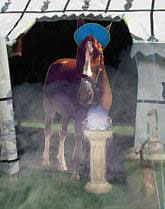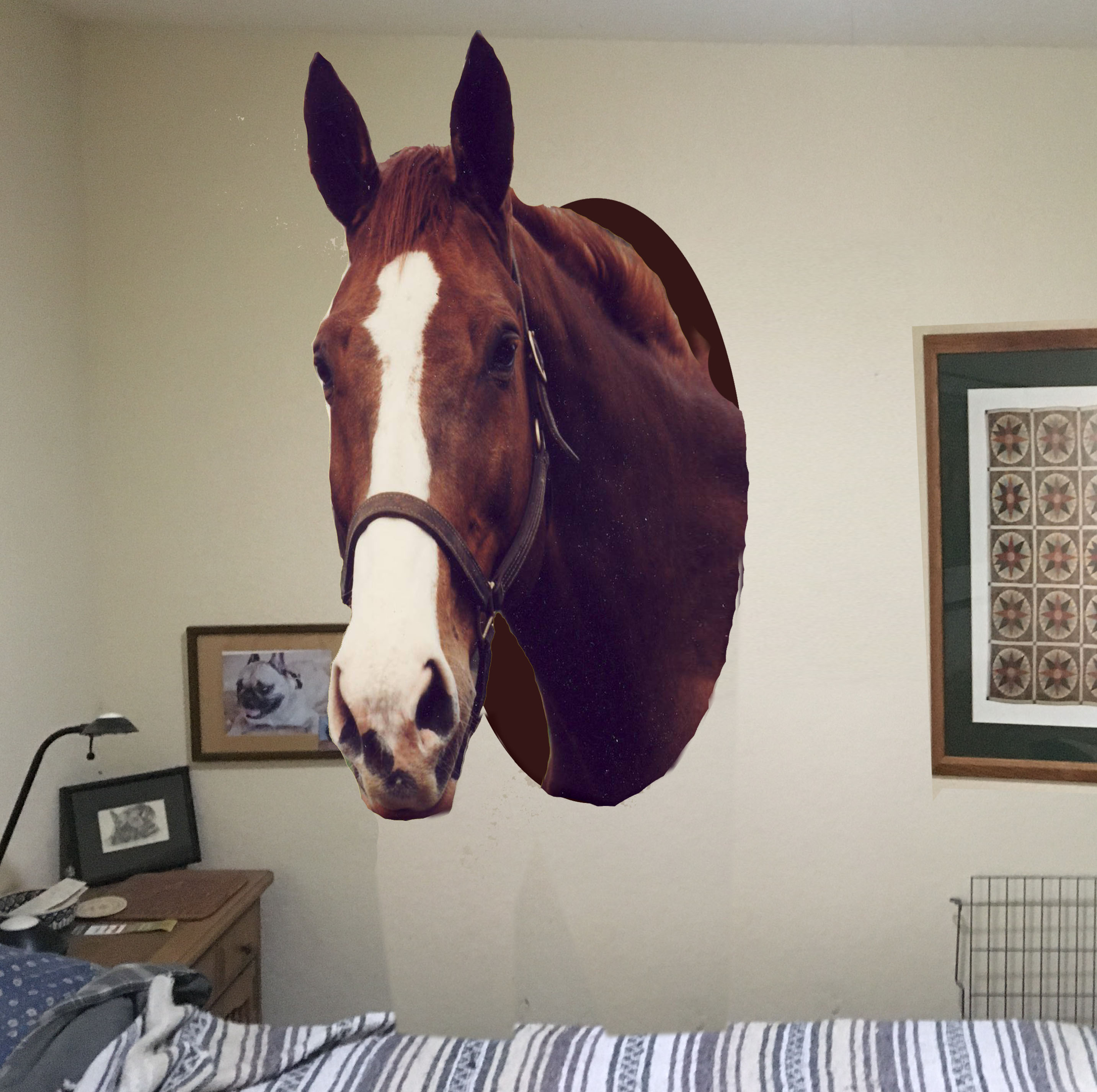(“It’s Wild Bill!”)
High on the list of qualities a good instructor must possess is the ability to quickly size up a horse’s strong and weak points and prescribe an effective program of training.
For your consideration: a bay gelding I met long ago in Montana whom they called Wild Bill. I was conducting a What’s Dressage All About? seminar, and he was to be one of the demonstration horses in the “basic” group. He wasn’t exactly the best selection—a three year old Thoroughbred—hot as a pistol, barely broke, leaping, shying, and prancing with abandon. The road to his dressage education appeared to be long and bumpy. Somehow he and his rider survived the weekend, and that was the highlight of their appearance.
A year later I returned for a follow up seminar. A well behaved, mature-looking bay horse appeared with the First Level group. “Do you recognize him?” I was asked.
Drawing a blank, I responded negatively.
“It’s Wild Bill!” they hastened to inform me.
“How is that possible?” I thought. “Last year he was a raging maniac.”
“Oh, I put him on a pack string for six months,” his owner explained. “After spending the summer with a bunch of mules hauling his load up and down the mountain, he became much more accommodating.”
We must also be interested and supportive, recognizing that our students have other interests outside the manège. A long-time student owned a mare whom she had trained to make, among other things, very nice piaffe/passage. Being from the Territories (meaning a red state anywhere west of the Hudson and east of Lake Tahoe but excluding a few places in Colorado where you can get a decent latte) one visit she proudly described to me all her dressage horse’s ancillary talents.
“AND,” she bragged, “she carried a bloody elk carcass draped over her withers down to our camp without a single complaint!” Caught off balance for a moment, I blurted back, “Well, why shouldn’t she? She’s been carrying you around all these years!” [Note to self: the rider had better be a pretty good friend and appreciate a good line no matter how untrue it is if you’re going to let stuff like this slip out!]
On other occasions the instructor must deliver bad news—if only to help the student aspire to something greater. Again out in the Territories, a guy brought a big warmblood stallion for a lesson. The trot work was admirable—active, scopey, expressive. The canter was another matter. It was beyond bold. Thelma and Louise careening over the cliff? No, more downhill than that. Bowling ball dropped from the Empire State Building? No, much more massive. But despite all that, this juggernaut’s rider seemed relatively pleased.
“Um, Sam, do you have an outdoor arena at home?” I asked.
He did.
“A good investment,” I advised, “might be to install a runaway truck lane beside it. When he gets cruising, you can point him across the gravel pile and up the hill. That ought to at least slow him down.”
We must also sometimes craft our advice in frank and direct terms so our students won’t forget. An opportunity for this sort of a less-than-gentle, behavior-modifying nudge arose when one familiar clinic rider arrived with a verrry obese horse. The organizer explained that this woman had been warned by her vet about the attendant health risks, but “she loves her mare sooo much, she can’t bear not to see a pile of T and A in front of her all day and all night.”
“So, Rachael,” I began, “Let me ask you a dressage riddle.
“What do the following all have in common? Bud Light . . . Met Life . . . FujiFilm . . . Outback . . . Direct TV . . . Goodyear . . . and Rachael . . . (pause) They all have blimps!”
Beyond the arena work itself, instructors have a responsibility to steer their students around fads and gimmicks that might waylay them in the marketplace—case in point: the delirium a while back around the idea of solving all your training and horse management woes by consulting a horse psychic. I knew all sorts of otherwise logical and educated people who were helping their local psychic make his boat payments. At the time Susan had a giant, amiable Swedish horse by the name of Dino. His body denied him much success at collection, but he was forever a good sport and a fine companion.
One day a career-changing idea for Dino popped into my mind. If people want somebody to interpret their horses’ thoughts, who better to do the job than another horse—one theirs can relate to. My plan was to acquire a small striped lawn tent and a smoke machine to set up in the vendor area at shows. Then, when he wasn’t in the arena showing, Dino could stand in the tent behind a table with a crystal ball and wearing a turban. The client’s horse would be sent into the tent with Dino. They would confer. Then Dino would pass on whatever he’d learned to us, and we would translate his message to the client while collecting Dino’s (substantial) fee for him.
people want somebody to interpret their horses’ thoughts, who better to do the job than another horse—one theirs can relate to. My plan was to acquire a small striped lawn tent and a smoke machine to set up in the vendor area at shows. Then, when he wasn’t in the arena showing, Dino could stand in the tent behind a table with a crystal ball and wearing a turban. The client’s horse would be sent into the tent with Dino. They would confer. Then Dino would pass on whatever he’d learned to us, and we would translate his message to the client while collecting Dino’s (substantial) fee for him.
I can’t remember why this didn’t make us rich. I think we got sidetracked by the Monica Lewinsky scandal. Or maybe it was Ross Perot. In any case, Dino lived out his life in contented retirement on  the farm. We decided to let him roam loose on the lawn, and to make him feel really at home, Susan had me cut an oval hole through the bedroom wall so he could peer in whenever he wanted. From inside he looked just like an elk or moose head hanging there.
the farm. We decided to let him roam loose on the lawn, and to make him feel really at home, Susan had me cut an oval hole through the bedroom wall so he could peer in whenever he wanted. From inside he looked just like an elk or moose head hanging there.
Except, of course, his eyes followed you.
